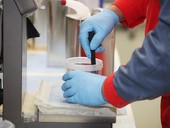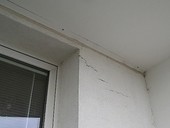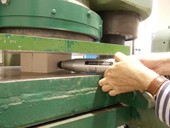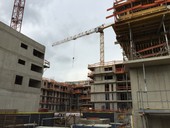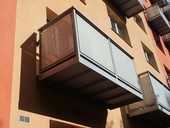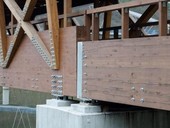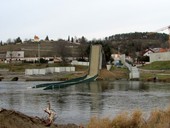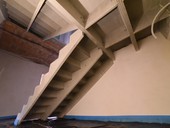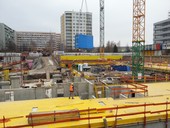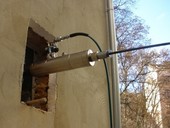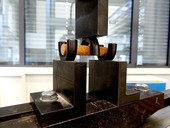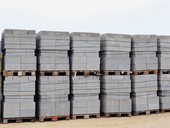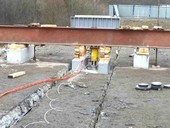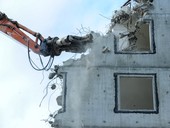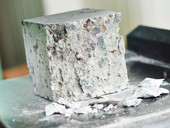The article briefly introduces basic technical terminology, errors and computational algorithms for estimating uncertainty of type A, type B, combined and extended uncertainty of test results and that the test management performs the tasks specified in the standard ČSN EN ISO / IEC 17025.
Archiv článků od 25.3.2019 do 25.11.2019
Treatment of wood surfaces with various finish coating materials is recommended for long term protection of wood products exposed outdoor. However, in practice it can happen that wood in constructions has been attacked by wood decay fungi before to application of a finish. In this work, selected properties of sapwood and heartwood of pine (Pinus sylvestris, L.) surface such as surface roughness and adhesion of coating film were investigated on the surfaces attacked by wood decay fungi (Coniophora puteana and Trametes versicolor) and wood staining fungus (Aureobasidium pullulans). Two coating materials useable for wooden constructions in exterior conditions were used: dark brown long-oil alkyd-based system and light brown oil-based surface treatment. The result of the pull-off test for adhesion of both surface treatments was significantly greater on the heartwood surfaces than on the sapwood surfaces of the sound wood. With the increasing time of wood degradation by fungi, the adhesion of the alkyd surface treatment decreased on the sapwood. Adhesion of the oil surface treatment was comparable on the both sound and decayed wood. According to the disruption analysis following the pulling of the dolly, the weakest point was the surface layer of the wood impregnated with coatings. The adhesion of the both surface treatments is comparable to the sound and wood affected with the staining fungus.
The paper deals with a case study of building defects inspection of Lužánky Free Time Centre in Brno. It is described the history of the building and the building diagnostics. There were used the survey methods of visual-defectoscopic inspection, semidestructive diagnosis and diagnosis of foundations and foundation soil. The conclusions contain recommendations for immediate and long-term solution of the object's static problems.
Rebound hammers complying with the specifications of ČSN EN 12504-2 resp. ČSN 73 1373 is used primarily for the determination of compressive strength of concrete in the structure. The paper presents the knowledge of the use of mechanical rebound hammer with impact energy of 0.735 N.m (type L) for the determination of compressive strength and tensile bending of calcium silicate bricks 290 × 140 × 65 mm. Calibration relationships for compression and tensile strength bending from the rebound number are presented. In practice, the calibration relationship for compressive strength prediction is applicable, the relationship for tensile bending strength does not show sufficient tightness between the variables and can only be used provided that a refinement coefficient is defined in the sense of ČSN 73 1370.
An important part of the construction is the lifting mechanism. If it is used properly and efficiently, the schedule and the completion date of the construction can be better followed. Incorrect or inefficient use of lifting mechanisms leads to unwanted downtime, failure to meet the potential of the mechanism, or overflowing it with a number of ongoing work processes. With the help of data collection (lifting load time), we try to map the use of lifting mechanisms throughout the construction. The obtained and properly evaluated data will serve as a basis for the simulation model to assess the effective use of the lifting device on the site.
Steel structures are preferably used to build existing structures. However, when designing them, it is necessary to adhere to precise principles to avoid malfunctions during operation, such as condensation of water, in case of poorly chosen structure of the structure. Some nondestructive testing methods can be used to detect these potential defects.
Survey of the real impact of historical and older constructions and constructions realized in the present period clearly shows that wood and wood-based materials are among efficient and still promising construction materials. The paper is compiled mainly on the basis of the knowledge gained during the verification of the properties of structures, in whose design and implementation the authors participated, and on the evaluation of the results of the survey of structures for the purpose of their remediation or reconstruction.
The prestressing reinforcement has been widely used to reinforce pre-stressed and posttensioned concrete structures. The recent failures of some prestressed bridge structures, caused by corrosion of the prestressing reinforcement, had generated strong interest from engineers in the problem of reinforcement corrosion and its corrosion protection. The paper presents our experience in the diagnostics of corroded prestressed structures in connection with the possibilities restoration of them.
A wide range of requirements are laid out for stair construction, which are based on general construction requirements. These are mainly structural fire resistance, static resistance, mechanical resistance, appearance requirements and more. This article focuses on existing material and structural solutions for staircases used in modern wooden constructions and on the possibilities of using cement-fibre boards to build a staircase. The article summarizes the general advantages and disadvantages of this solution and represents the basic design solution.
The lifting mechanisms are mainly used during construction of building structures for easier manipulation with the material or formwork elements. The most complicated cases are with monolithic structures. These structures need to move large amounts of material and formwork at the same time. The effective use of the lifting mechanisms can lead to acceleration of construction. Nowadays the measured performance standards are not usable. That leads to create own database. The article deals with the collection of time data for using of the lifting mechanisms in real constructions for the process of formwork of monolithic floor structures. The evaluated data will be verified and compared by T-cycle based calculation. The article is divided on theoretical and experimental part.
Old historic masonry structures are in many cases in a poor construction-static state. The repaired building showed a loss of horizontal and vertical joints, cracks and local defects of vaults, walls, ceilings, roofs and foundations. Therefore, rigid prestressed reinforced concrete foundations have been proposed and pretensioned rods located in the lower parts of the vault arches were installed.
The article presents the modified configuration of the longitudinal shear test of composite bars based on ASTM D 4475. The aim of the experimental program is to verify the possibility of using a three-point bending test to evaluate the resin quality and resin/fibre interface. The study focuses on influence of distance between support on calculated interlaminar shear strength. The properties of the resin are influenced by the alkaline environment. Resistance of the resin and resin/fibre interface exposed to this environment was determined by the test. An influence of the alkaline environment on interlaminar shear strength of FRP members was observed on both types of tested FRP bars.
The article is focused on the analysis of connections of timber elements with doweled type steel elements. The main scope of the article is to assess a load bearing capacity and stiffness of different types of doweled connections and comparison of theoretical results with results obtained from experimental tests. Subject of the research were connections composed of C24 grade solid timber elements connected with nails, screws, dowels, threaded rods and bolts. Findings and conclusions derived from the analysis of assumed connections can be used for a design and execution of doweled type connections in timber structures.
Using the appropriate secondary raw materials, it is possible to reduce the bulk density of AAC while preservation the physical-mechanical properties, e.g. strength. This reduces the total weight of the construction and allows for wider use, for example, in the application of material to reduce the load on non-load-bearing walls or to increase floor levels. Research is focused on the use of 10%, 30% and 50% admixture of fluidized bed combustion ashes and slag in the AAC. AAC was developed in the hydrothermal conditions of the autoclave at 7 hours of isothermal soak at 190 °C. The results showed the dependence of the rheological properties on the amount of admixture of fluidized bed combustion fly and bottom ash, slag. Research has shown that the use of 10% admixture of secondary raw materials will not significantly affect the physical properties of the samples.
We can observe a bad or even a state of emergency condition of the several bridges which are today in service for more than 60 years. There were find out on the structures any serious failures such as excessive deformations, extensive cracks, corrosion of prestressing wires and the anchors, etc. One of the most important thing in the process of the existing prestressed structures reliability evaluation is to determine the current level of prestressing in concrete structure. There have been developed in the world and in our country several methods that enable predict the current level of prestressing in a structure. This paper discusses the possibilities of determining the prestressing level on an existing structure using the indirect method as (Structural response method) founded on the theoretical-experimental base. This method was applied on an example of the precast prestressed bridge girder analysis after its 60 years in service.
This paper presents utilization possibilities of micronized recycled chemically activated concrete powder. So far, these fines of waste concrete have not been used in technical practice. Combination of micro milling and chemical activation were carried out using suitable admixtures such as fly ash or slag. These showed to be one of possible ways how to reuse such materials and apply them during production of new cement binder and concrete. In this paper, microscopic analysis of thispowder was carried out. Moreover, an impact of chemical activation on resulting mechanical properties was investigated.
Fibre-reinforced concrete is increasingly used in structures where its properties can be utilized - especially tensile and residual strength after cracking. For applications in load-bearing fibre-reinforced concrete structures, it is necessary to ensure the uniformity of the steel fibres distribution in its structure. The paper summarizes the current knowledge of fibre-reinforced concrete production and test methods, which can be used to monitor the uniformity of fibres distribution in both fresh and hardened fibre-reinforced concrete.
The present research work at primary phase deals with the development of high strength heavyweight concrete based on cementitious composite comprising alternative raw materials and two types of high density aggregates (barite and magnetite). The design of concrete is based on six mortar specimens from which concrete blocks and prisms are prepared for physical and mechanical properties tests.
Mechanical Activation of Concrete: Determination of Efficiency for Differend Kinds of Waste Concrete
Waste concrete contains a portion of non-hydrated particles within a concrete paste. Because it is a valuable material, ways how to reactivate and apply them during production of new materials are searched. The mechanical reactiovation seems to be a potential technique to achieve that. This method is based on very fine milling of waste concrete, resulting inmicronized powder. In the course of such process, unhydrated grains are uncovered. Hereby, these can be involved in future hydratation processes. In order to find the efficiency of such reactivation, the combination of two methods was employed, describing the shape and phase composition of the resulting grains. Three different kinds of waste concrete were tested, differed in their age, use, and method of production. It was found that old concrete waste with Belitic binder is the most suitable of them for the mechanical activation.
zpět na aktuální články
